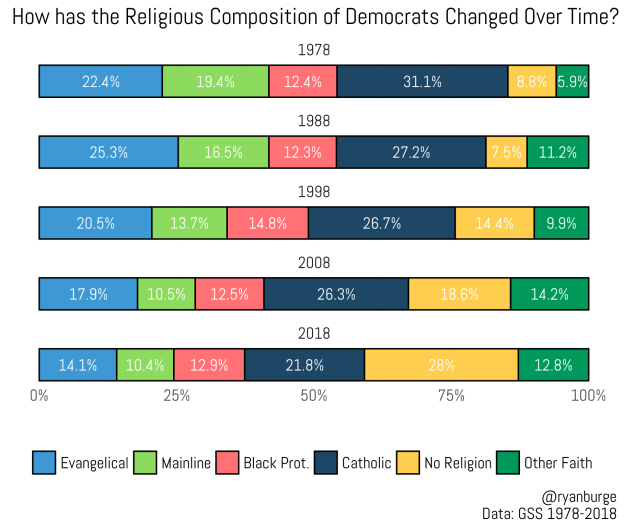What Is The Religious Makeup Of The Democratic Party?
past Ryan P. Burge, Eastern Illinois University
I make a lot of information visualizations. Most of the time I have a pretty good thought of what the results of the calculations are going to await like before I write the lawmaking. In fact, some of the results are so obvious that I don't even post them anywhere, they just live on my hard drive until information technology fails. Then sometimes I make some graphs that I stare at for a long fourth dimension and am still finding new things that I didn't see on first inspection. That'southward what happened over the weekend. To give some context, I was thinking virtually how little I really understood the religious composition of the two major parties back in the 1980s and 1990s. It'southward well known that the Religious Right has been transformative for American politics, but how has that changed the makeup of the Republican Party? And, now that religious nones are a quarter of the population, their presence must be felt past the Democrats and the GOP.
Then I just did some unproblematic analysis.
I grabbed the General Social Survey and and then made a snapshot of the religious composition of both the Republicans and the Democrats, every ten years starting in 1978. I did make one modification to the traditional RELTRAD categories by combining Jews, those of minority religions (Buddhism, Hindus, Mormons, etc), and those that become unclassified in RELTRAD into a single category that I chosen "other faith." It makes interpreting the graphs much easier. Let'south get right to it: this is the religious composition of the Democratic party over the last forty years.

The first thing that jumped out to me is that the largest contingent of Democrats in 1978 was Catholics, followed by *evangelicals* at 22.4%. Permit that sink in: nearly a quarter of all Democrats in 1978 were evangelical Protestants. Mainline Protestants followed closely behind at 19.4%. Black Protestants were 12.4% of Democrats (and basically haven't actually inverse over time). The nones were about 9% of all Democrats.
Then things shifted, a lot. The percentage of Democrats who are mainline Protestants has shrunk in one-half from ~20% to just 10% now. That's non due to a mainline exodus toward the Republicans, that'south due to mainliners disappearing altogether. The share of Democrats who are Catholic has shrunk basically the same amount, ten percentage points. And, the Democrats have lost share amid evangelicals who are now xiv.1% of Democrats, which is higher than I would take guessed at present and still the third largest group among Democrats.
That's a lot of losses. In total that's about 27% of losses between mainliners, evangelicals, and Catholics. Where did the gains come from? Well, mostly from the nones. In fact the share of Democrats who place as nones has jumped almost twenty percentage points since 1978. At the same time, those of "other faith" have increased significantly likewise, by most seven percentage points. And that's actually the entirety of the shift for Democrats: losses amidst evangelical and mainline Protestants and Catholics with huge gains amidst the nones and the others.

How about the Republicans? In 1978, 2 out of iii Republicans identified as evangelical or mainline Protestant. That is still stunning to me. As nosotros have written before, we need to jettison the thought that mainline Protestants are the "liberal" type of Protestant Christianity, when in their heyday, mainliners were twice every bit likely to be Republicans every bit Democrats. On the right side of the graph we meet that Catholics made up eighteen.6% of Republicans, while the nones were well-nigh 5%.
Some of the changes within the Republican coalition are staggering. For example, the xl% of all Republicans that were mainline Protestants has now shrunk to 15%. That'south a 25 point loss by one group. And, again, that's basically considering mainline Protestants are now a 3rd the size they were in 1972. That's really the group that has seen a driblet off among Republicans. How about gain? Well, evangelicals are up, but not as much as people would likely think: just vii.half-dozen%. Today, it's authentic to say that i tertiary of all Republicans are evangelicals – which means that this is the largest faith group contingent in either political party. There have also been some significant gains among Catholics, too, at just over half-dozen percentage points. That's not terribly dissimilar than the gain among evangelicals, but this is a story that seems to get uncovered by the media. It's also notable that the nones are at present 13.6% of the Republican coalition. In fact, the nones are about the same portion of Republican every bit mainline Protestants. Recollect earlier that the Democrats have gained about twenty points from the nones, but the Republicans gained most nine points themselves. So, information technology'due south non accurate to say that the nones are completely captured by the Autonomous Political party; instead if 1 just looks at partisanship nones it appears like two thirds of them are Democrats, and the others are Republicans.
It's somewhat comforting to note that neither of the 2 major parties in the Usa are dominated by one specific religious group. I know that tons of articles are written the link between evangelicals and Republicans, just the data indicates that over two thirds of Republicans today are non evangelicals. The same is essentially true for Democrats every bit well. The largest grouping for them (the nones) make up just three in x Democrats today. There is room in either tent for a member of any religious group.
Ryan P. Burge teaches at Eastern Illinois University in Charleston, Illinois. He tin be contacted via Twitter or his personal website. The syntax for the mail can exist establish in hither.
What Is The Religious Makeup Of The Democratic Party?,
Source: https://religioninpublic.blog/2019/04/25/the-religious-composition-of-the-two-major-parties/
Posted by: williamsalannow.blogspot.com


0 Response to "What Is The Religious Makeup Of The Democratic Party?"
Post a Comment